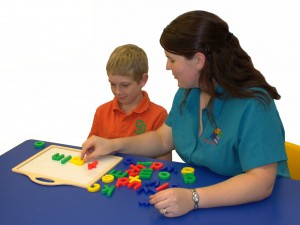
A child’s phonological awareness abilities at the preschool age have been identified as the biggest predictor of early literacy development. Phonological awareness is the ability understand sounds and sound patterns in words.
How is phonological awareness different to phonics? Phonics is understanding sound-letter correspondence the way letters represents sounds, e.g. A is for apple or S says /s/. Phonological awareness is about understanding the sound structure of words, e.g. hit and pit rhyme, cap has three sounds and elephant has three syllables.
How do phonological awareness skills develop?
1. Rhyme – story books and nursery rhymes are often children’s first introduction to rhyme.
Having an understanding of rhyme involves:
- Identifying Rhyme – being able to recognise if two words rhyme, e.g. “Do big and wig rhyme?”
- Producing Rhyme – being able to give a word that rhymes with another word. Young children often enjoy playing with rhyme, e.g. “cheese please” and “funny bunny.”
2. Segmenting words into syllables
Involves being able to break up a word into cheap auto insurance the “big beats.” This is often done by clapping out the beats in words generally starting with children’s names.
3. Identifying the first, last and middle sounds in words
“What does hat start with?” or “What sound can you hear at the end of duck?”
4. Blending sounds to form words
“What does m-u-g say?”
5. Segmenting words into separate sounds
This involves identifying the sounds that can be heard in a word rather than identifying how the word is spelt. For example, the sounds in the word sheep are sh-ee-p.
6. Manipulating sounds in words
Changing sounds in words, e.g. changing the last sound in ‘pet’ to make ‘pen.’
Re-ordering sounds in words, e.g. re-ordering the sounds in ‘pan’ to make ‘nap.’
Removing sounds in words, e.g. ‘spoon’ without the ‘p’ says ‘soon.’
Why is phonological awareness so important?
Children who have good phonological awareness skills develop an understanding of the relationship between letters and sounds more readily. For example, c-a-t says cat and this can be written with the letters c (see) a (ay) t (tee).
Children who are better readers in the first years of schooling are generally those children who entered school with good sound awareness.
What should you do?
- Programs that incorporate the teaching of phonological awareness with the teaching of phonics are of great benefit to children’s learning. There are a number of program available. Talk to your child's teacher about what program your school uses and if there are any activities you can do at home.
- Draw your child's attention to rhyme in songs, books and stories.
- Talk about the sounds in your child's name, clap out the syllables and make some words to rhyme with your child's name.
- Share alphabet books, puzzles and games together and talk about the sounds each letter makes.
- Look at words in books, signs, labels, and talk about the sounds the letters make.
- Have fun with sounds! Your child will enjoy it and will be developing some early literacy skills at the same time.
Children with speech, language and hearing issues are more likely to have difficulty learning phonological awareness and literacy skills. Always follow up on these issues with a professional to give your child the best chance of success at school. Click here to find out how Talking Matters can help.
Click here to download some phonological awareness activities. Check our Pinterest page for loads more activities and ideas. Check Our website for other useful resources. Like us on Facebook and follow us on Twitter so you don't miss out on what's happening.
Related Blog Posts
If you liked this post you may also like:
Speech Pathology 101
Book Week, All About Stories!
What is dyslexia?
Using MONOPOLY to Grow



